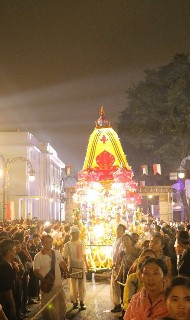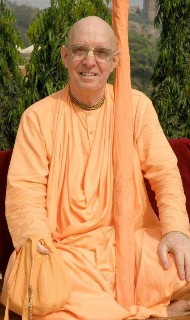
Parikshit Maharaja Pastime Analysis
Read More...
Websites from the ISKCON Universe
 We welcome you to this most auspicious place, the temple of Sri Sri Radha-Radhanath, on the most auspicious occasion of the beginning of Kartik, in the most auspicious association of Lord Krishna’s devotees. Kartik is also known as the month of Damodara (dama means “ropes,” and udara means “abdomen”), Krishna who allowed Himself to be bound about the waist by the ropes of His devotee’s love.
We welcome you to this most auspicious place, the temple of Sri Sri Radha-Radhanath, on the most auspicious occasion of the beginning of Kartik, in the most auspicious association of Lord Krishna’s devotees. Kartik is also known as the month of Damodara (dama means “ropes,” and udara means “abdomen”), Krishna who allowed Himself to be bound about the waist by the ropes of His devotee’s love.
Srila Rupa Gosvami compiled the law book of Krishna consciousness, the science of devotion, in the Bhakti-rasamrta-sindhu, translated by Srila Prabhupada in a summary study as The Nectar of Devotion. There the observance of Kartik is mentioned as one of the sixty-four items of devotional service. Rupa Gosvami quotes from the Padma Purana that just as Lord Damodara is favorably inclined toward His devotees, so the month of Kartik, which is also dear to Him, bestows great favor upon them, even for a little service or a little practice. It is even said that the benefit gained for service performed in the last five days of Kartik is equal to that gained from service performed for the entire month. In other words, for a very small performance of devotional service in the month of Damodara, one gets a very big result—especially in Vrindavan. Also, Srila Prabhupada has explained that wherever the Deities of Radha and Krishna are installed, that is also Vrindavan. So, even here our devotional service will be magnified “one thousand times.”
Srila Prabhupada gives us the example of a store that has a sale, when a customer can get a very valuable item for a very low price. So, the month of Kartik is like a sale, a transcendental sale. By a little investment in terms of spiritual practice and service, you can get a great benefit. Of course, the management of the store hopes that you will come to appreciate its goods and patronize the store even after the sale is over. So we too hope that you will continue with your spiritual practices, or your increased practices, even after the month of Kartik.
There is a special potency to the month itself. Just as certain times of the day, such as the brahma-muhurta, which begins one hour and thirty-two minutes before sunrise and continues until the sun rises, are more auspicious for spiritual progress and enhance the value of one’s practices, so too, within the year, the month of Kartik is most auspicious. Devotees try to take advantage of the facility offered by Kartik by on the one side increasing their spiritual practices and doing extra service—they chant more rounds, read more scripture, recite more prayers, distribute more books, and make special offerings—and on the other side decreasing their material involvement, their sense gratification. As it is, we are in the four-month period of Caturmasya, so every month we forgo a certain type of food, but in Kartik devotees may do extra austerities. They may eat only once a day, or give up sweet or fried foods, or rise earlier than usual, or whatever—work on some area of their spiritual life that they want to improve—and they get special mercy in the month of Kartik to fulfil their vows and improve their spiritual practices.
Today also is sarat-purnima, the full-moon night of the sarat season, the night on which Krishna played upon His transcendental flute at Vamsivata by the Yamuna River in Vrindavan and called the gopis to dance with Him. Now, we may take it that He played on His flute and in a figurative way called the gopis to dance with Him, but actually Krishna’s flute is one of His messengers, and so the gopis not only heard the beautiful, melodious sound of the flute but also received the message that Krishna wanted to meet them. And because their only desire was to please Krishna, to fulfil His desires and make Him happy, they all went to Him—not with the aim of fulfilling any selfish desire of their own, but with the sole aim of fulfilling Krishna’s transcendental desire to dance with them.
Because the rasa dance superficially resembles the dancing of men and women in the material world, it can easily be misunderstood, and there are critics of Lord Krishna and Srimad-Bhagavatam and Krishna consciousness itself that find fault with the rasa-lila. I know religious groups outside of the Vedic tradition who criticize and challenge, “Oh, Krishna is a womanizer. How can you worship a god who enjoys with women?” They do not understand the pure love exchanged by Krishna and the gopis. In Sri Caitanya-caritamrta, Srila Krsnadasa Kaviraja Gosvami explains the difference between love, or prema, and lust, or kama. In lust, the person wants to gratify his or her own senses, whereas in pure love, the devotee wishes to satisfy Krishna’s transcendental senses. The two may resemble each other, but actually they are completely different.
kama, prema,—donhakara vibhinna laksana
lauha ara hema yaiche svarupe vilaksana
atmendriya-priti-vancha—tare bali ‘kama’
krsnendriya-priti-iccha dhare ‘prema’ nama
“Lust and love have different characteristics, just as iron and gold have different natures. The desire to gratify one’s own senses is kama, but the desire to please the senses of Lord Krsna is prema.” (Cc Adi 4. 164–165) Iron and gold are both metals, but there is a great difference between them in their value. The pure love of the devotees for Krishna is like gold, and the lust of people in the material world who want to gratify their senses is like iron.
Another point of contention related to the Tenth Canto of Srimad-Bhagavatam is that the name of Radha is not mentioned. Some people challenge, “You are worshiping Radha and Krishna, Radha-Radhanatha, but on what authority? We don’t find the name of Radha in the Bhagavad-gita or Srimad-Bhagavatam.” But in the five chapters that describe the rasa-lila, we find that after Krishna called the gopis and began to reciprocate with them, He disappeared. The gopis were then plunged into separation from Krishna, and they began to search all over the Vrindavan forest for Him. In time, they found two pairs of footprints: Krishna’s and a gopi’s. Then the other gopis, in their separation, exclaimed:
anayaradhito nunam
bhagavan harir isvarah
yan no vihaya govindah
prito yam anayad rahah
“Certainly this particular gopi has perfectly worshiped the all-powerful Personality of Godhead. Therefore Govinda was so pleased with Her that He abandoned the rest of us and brought Her to a secluded place.” (SB 10.30.28) “Because She worshiped Lord Hari better than all of us, She has gotten to be with Krishna now.” The word aradhito, which means “worshiped” or “perfectly worshiped,” refers to Radha, as confirmed by Srila Visvanatha Cakravarti Thakura and other acharyas. They explain that Her name does appear in the Vedas, Upanisads, and other Puranas, and that in this verse, although Her name is not mentioned explicitly, the superexcellent glories of Sri Radha are nonetheless proclaimed.
Ultimately, Krishna also left Srimati Radharani, and when the other gopis came upon Her, they found Her in such a state of intense lamentation in separation that they felt, “Actually, She loves Krishna more.” There is a technical discussion of what actually took place in the rasa-lila, why Krishna left with Radharani and why eventually He left Her too. But His ultimate purpose was to reunite all the gopis, and when the other gopis saw Srimati Radharani in such a state of ecstasy in separation, they felt sympathetic toward Her. They did not feel any envy at all.
So, they all searched for Krishna together. But they could not find Him anywhere. Finally they decided, “We cannot find Krishna unless He wishes to be found. We cannot force Him to come before us.” They considered, “How can we attract Krishna’s attention? How can we move Krishna to come back to us?” And they concluded that the best method was sankirtana, chanting the glories of Krishna together, along with crying.
So, they returned to the bank of the Yamuna where they had originally met Him and began to sing the glories of Krishna—beautiful songs in separation, known as the Gopi-gita. And when Krishna heard the loving prayers of the gopis, their sankirtana, His heart was moved and He could no longer stay away from them. He came and reappeared before them in His most attractive feature:
tasam avirabhuc chaurih
smayamana-mukhambujah
pitambara-dharah sragvi
saksan manmatha-manmathah
“Then Lord Krsna, a smile on His lotus face, appeared before the gopis. Wearing a garland and a yellow garment, He directly appeared as one who can bewilder the mind of Cupid, who himself bewilders the minds of ordinary people.” (SB 10.32.2)
Then followed a very interesting dialogue between Krishna and the gopis. The gopis felt some transcendental anger because Krishna had abandoned them. After all, He had called them to Him, they had risked everything to go to Him in the dead of night, and then He had left them. So they wanted Krishna to explain why.
In a most tactful and intelligent way, they began, “There are three kinds of lovers.” They presented three categories of lovers, or different ways that lovers deal with others, and asked Krishna to explain them. Indirectly, they were asking Krishna, “In which category do you fit?”
In one category are people who reciprocate exactly with the other party. In other words, “If you are kind to me, I will be kind to you; if you ignore me, I will ignore you.” Krishna said, “They are like merchants. They give only with the expectation of return, and they give only as much as they expect in return. Actually, they are selfish.”
In the next category are those who love the other even though the other does not love them. For example, at least in principle, parents love their children no matter what the children do. The children may not even appreciate the parents’ service, but the parents go on loving and serving them. And even better than parents are devotees, because although parents serve their own children, devotees love and serve everyone. Whether others appreciate them or not, they try to help everyone. Krishna said, “Those who love others even if others don’t love them in return, they are following the true path of dharma and they are the true friends of humanity.”
In the third category are those who don’t reciprocate even when others love them. The first category is “I reciprocate only if you love me.” The second category is “Even if you don’t love me, I love you.” And the third category is “Even if you love me, I don’t reciprocate.” So, the gopis wanted Krishna to admit that He was in the third category. They did not want to say it themselves; they wanted to hear it from Krishna’s own mouth. They wanted to trap Him with their subtle network of wise and clever words.
Now, within the third category there are four divisions. There is the atmarama: He is completely self-satisfied. Even if you love him, he won’t reciprocate, because he is self-satisfied; he is situated in transcendental bliss. Then there is the apta-kama: He has desires, but they are already satisfied, so he doesn’t need you. Even if you love him, he won’t reciprocate. Then there is the third division, akrta-jna: he is ungrateful. And then there is the last division, guru-druhah. In the first three, “You love me, but I don’t reciprocate; I remain indifferent,” but in this last category, guru-druhah, “You love me, and I am not just indifferent to you; I become inimical.” Actually, the gopis wanted Krishna to admit that He had been ungrateful.
Finally, Krishna had to respond to their question, and His answer was, “I did not neglect you, nor was I indifferent to you. I was always thinking of you. But in order to increase your love for Me, I hid Myself from you.” Krishna gave the example of a poor man who gains some wealth and then loses it. He will be so anxious that he can think of nothing except his lost treasure: “What happened to my money? How can I get it back?” Krishna said, “So I was reciprocating with you, because your desire was to increase your love for Me, and by hiding Myself from you I created a situation by which your attachment for Me would increase. So I was reciprocating with you.” Although Krishna’s argument sounded good, it did contain one defect: the gopis’ love was already unlimited, and even so, by its very nature it was always increasing. So that could not have been the real reason.
Again, there is an intricate and elaborate discussion by the acharyas about the dialogue between Krishna and the gopis, but at the very end Krishna admits defeat. He says,
na paraye ’ham niravadya-samyujam
sva-sadhu-krtyam vibudhayusapi vah
ya mabhajan durjara-geha-srnkhalah
samvrscya tad vah pratiyatu sadhuna
“Actually, I am unable to repay My debt for your service to Me even with the prolonged life of Brahma, because you have given up everything for Me. You have given up family ties, which are so difficult to break. You have given up the dictates of the world, of the Vedas, and of your relatives. You have forsaken everything for My sake—which I could not do for you. You have given up all other relationships for Me, but I could not do that for you. I still have My father and mother and friends. You came running out of your houses in the middle of the night, but I sneak out and return in the morning so that no one catches Me. But you, with complete abandon, have come to meet Me without any consideration of the consequences. And I have so many devotees with whom I reciprocate: devotees in madhurya-rasa, in vatsalya-rasa, in sakhya-rasa, in dasya-rasa, and in santa-rasa. I also reciprocate with the sadhakas in the material world who are struggling and trying to become devotees. I reciprocate with everyone who approaches Me. But you love only Me. So I cannot equal your love. I admit it: I can never repay My debt to you.” He concluded, “I am defeated by your love.”
The gopis were so touched by Krishna’s words that they thought, “Now He has defeated us! We could not admit to Him that He defeated us, but He has admitted to us that we defeated Him. So He has defeated us!” Of course, this is all on the platform of transcendental love. And it is said that later, when Krishna left Vrindavan to go to Mathura and Dvaraka and the gopis were left in separation from Him, they would think of His words to them, na paraye ’ham, and that would give them solace to bear the separation. Of course, here we come to another subtle and intricate discussion, because even in separation from Krishna they experienced His presence.
After hearing Krishna’s reply, the gopis were appeased, and so He began the pastime of the rasa dance. All of the gopis were dancing in a circle, and Krishna expanded Himself to be next to each one. Each gopi felt, “Krishna is with me alone,” and each was completely satisfied by Krishna.
One of our godbrothers, Garuda dasa Adhikari (Graham M. Schweig), is a professor at a university in the United States, and he has written a translation and study of the rasa-panca-adhyaya, the five chapters in the Tenth Canto of Srimad-Bhagavatam that describe Sri Krishna’s pastimes of the rasa dance, which has been published by Princeton University Press. He uses the image of the rasa dance as a symbol for interfaith harmony. It is a symbol that is most appropriate, especially for a diverse country such as South Africa.
The idea is that there were so many gopis, and each was individual, but that Krishna was by the side of each one, reciprocating with each perfectly. He accepted all of them, and they all accepted one another, and there was complete harmony—not only between Krishna and the gopis but also among the gopis themselves—in this dance of divine love. So, different worshipers serve God in different ways. They have different practices and rituals, and different scriptures and languages. But God reciprocates with all of them. And if they can come into harmony, not only with God but also with one another, in the dance of divine love, then there can be complete harmony in the world.
So, today is a most sacred occasion: the beginning of Kartik-vrata, and sarat-purnima, the night Krishna enjoyed His rasa-lila with the gopis—after removing Himself from their presence in order to demonstrate to the world, in their separation from Him, their supreme love.
Thank you very much.
Hare Krishna.
[A talk by Giriraj Swami, October 17, 2005, Sri Sri Radha-Radhanath Temple, Durban, South Africa]

Iskcon Arouca free food distribution for flood victims in St. Helena and Kelly village area (Album of photos)
Proud to be a T...
 By Nila Kamala
By Nila Kamala Bandung is a small island in Indonesia. The annual anniversary of the city took place on the 21st of October this year. To celebrate this event, throughout the city there is a parade with a variety of arts, acts and performances. As usual, the devotees joined the parade being invited by the Government. Continue reading "5th Ratha Yatra Festival in Bandung, Indonesia
→ Dandavats"
Answer Podcast
The post By helping others we may feel a sense of self-worth, but won’t it increase our ego too? appeared first on The Spiritual Scientist.
Bhagavad-gita verse-by-verse podcast
The post Gita 01.20 Life is so unpredictable that it can unbalance the unflappably balanced appeared first on The Spiritual Scientist.
[Talk at Intel, San Jose, USA]
Podcast
Podcast Summary
Video:
The post Transform your mind, transform your world appeared first on The Spiritual Scientist.
The post When life hurts(3) appeared first on The Spiritual Scientist.
 Kendari is the capital of the Indonesian province of Southeast Sulawesi. The city lies along Kendari Bay. The festivities for the Ratha Yatra were arranged at the district football ground of Ladongi in Loea District. Devotees started to arrive a day ahead of the festival especially devotees from Amongedo district. Saciputra Das and Ramanuja das from Bali arrived at Jati Bali, 3 hours’ drive from Ladongi, with 30 kilos of flowers for decorating the chariot. Bhakta Gede Sukanta and his wife kindly arrange to receive the devotees at their residence where we had kirtan, class and, of course, prasad. Since we had to start very early the next morning seeing the constraint on time all devotees worked together to prepare the garlands throughout the night.
Kendari is the capital of the Indonesian province of Southeast Sulawesi. The city lies along Kendari Bay. The festivities for the Ratha Yatra were arranged at the district football ground of Ladongi in Loea District. Devotees started to arrive a day ahead of the festival especially devotees from Amongedo district. Saciputra Das and Ramanuja das from Bali arrived at Jati Bali, 3 hours’ drive from Ladongi, with 30 kilos of flowers for decorating the chariot. Bhakta Gede Sukanta and his wife kindly arrange to receive the devotees at their residence where we had kirtan, class and, of course, prasad. Since we had to start very early the next morning seeing the constraint on time all devotees worked together to prepare the garlands throughout the night. 
If the violent communication is from the both, take the responsibility from your part and express and then the best is you dont repeat it, the best apology is change your behavior and change behavior requires something inside not just outside, so i am an imperfect being making this apology, i may make the same mistake again because i am an imperfect being and I am acknowledging my mistake and i am acknowledging my shortcomings. I earnestly and honestly will try to improve. If you want to be in mode of goodness instead of passion and ignorance be in the mode of goodness without expectation by that you become good association and there is a possibility of mode of goodness response because you are in mode of goodness, make the change in the heart consistently.

Bhagavatam is the Answer!
Giriraj Swami: I have been rereading the First Canto of Srimad-Bhagavatam and receiving great illumination and inspiration from it. Srila Prabhupada said that he was not sure how long he would live, so he put everything into the First Canto, and Ramesvara Prabhu told me that whenever he told Prabhupada that the BBT had money and asked what they should print, Prabhupada would reply “Reprint the First Canto.”

Meet Councillor Das Dipa.
A devotee of Krishna and disciple of HH Jayapataka Swami won the local election in May 2018. She stood as a councillor and won. She was voted in as councillor in St Dunstan’s Ward in Tower Hamlets in the UK.
Read more: https://goo.gl/f3MVNf
 By Keshava Bharati Das Goswami
By Keshava Bharati Das Goswami The readers of your books also become deserving of worship. And the active principle that underlies hearing with proper consciousness—with complete faith, without argument, in rapt attention—is the blessing of an eternal associate of the Lord. Srila Prabhupada, you are the eternal associate of the Lord who made it possible for the world to taste real relief from the sufferings of the degraded Age of Kali and to feel true happiness by reading your books, especially out loud. Continue reading "Reading Srila Prabhupada’s Books
→ Dandavats"
Mayapur Times is a newsletter of the Sri Mayapur Candrodaya Mandir. The newsletter aims to inform and inspire the local ISKCON community by reporting monthly activities, events, developments and news. Mayapur Times August 2018 Issue !
The post Mayapur Times : Mayapur’s e- Newsletter appeared first on Mayapur.com.

Surrender to Krishna conscious principles.
Srila Prabhupada letter to Rayarama, Oct. 22, 1971
My Dear Rayarama,
Please accept my blessings. I am in due receipt of your letter dated 11th October 1971 and have noted the contents. I welcome you for your coming back to our society and you are feeling very nicely the association of devotees.
Srila Rupa Goswami has described that devotional service can be advanced by six processes. Perhaps you know them. They are as follows: enthusiasm, patience, conviction, following the regulative principles, being honest in one’s profession, and in the association of devotees.
So this Krishna consciousness society is especially meant for giving people the opportunity to associate with devotees. Devotees means who are following the regulative principles. One cannot be independent and at the same time become a devotee because all devotional activities are based on surrender.
Read More...

The glories of Srimad Bhagavatam, the spotless Purana (video)
Srimad Bhagavatam Class by HH Devamrita Swami - 21 October 2018,...

Karthik 2018 - CHAD Message from Vaisesika Prabhu - BG Chapter 5 (1 min video)
Read Bhagavad Gita Chapter 5 every day during K...
 By Gauranga Darshan Das
By Gauranga Darshan Das Every living entity is a part and parcel of God, and thus has an eternal relationship with Him. Although one has relationships with many others in this world, they begin when one enters a material body and end while leaving the body. But one is eternally related to the Supreme Lord Sri Krsna. The source of the love within all of us is Krsna and Krsna is the ultimate object of our love too. Therefore, everyone loves Krsna the most, and it is Krsna who loves a person the most. Just as the living being is eternal, his love for God is also eternal. If we love someone, we love the things and people related to that person. Thus, understanding one’s eternal relationship with God and loving Him doesn’t make one indifferent to friends and family members, but makes one love them in true spirit. Continue reading "The Epitome of Love – Purity and Simplicity of Gopis’ Love for Krishna
→ Dandavats"
 By Mathura Lilesvari Devi dasi
By Mathura Lilesvari Devi dasi I am writing this note to thank all the wonderful devotees of Gita Nagari Dham in Port Royal, Pennsylvania USA and to exhibit the beauty and importance of association in a devotional community. Immediately after my injury, long time Gita Nagari residents, my mother in law and sister in law, Syama Gopa Rupa Dasi and Prema Sankirtana dasi both arrived in our home to help me. Prema decided to stay on until I can walk again. She gave up the comfort of her home and decided to help me even before I asked for help. Such was her training. As the bathroom at our home was on the first floor, I decided to stay there. Going up and down the stair was a torture. So Prema would bring me breakfast, lunch and dinner every day. She was so good in understanding exactly what I wanted. Continue reading "Caring devotees of Gita Nagari Dham
→ Dandavats"
Answer Podcast
Transcription :
Transcribed by: Keshavgopal Das
Question: If we learn to depend on mentors, but then they aren’t available when needed, what can we do?
Answer: An ideal counsellor is one who progressively make himself redundant. In Gita, Krishna does not decide for Arjuna. However, he provides Arjuna a framework based on which he should take decisions on his own even when Krishna is not around.
Srila Prabhupada also wanted that his disciples be independently thoughtful. He also wanted that his disciples continue with Krishna bhakti even when he is not there. For a mature disciple, the teachings and wisdom of a spiritual master or mentor become internalized based on which he can continue to guide himself in the absence of the spiritual master.
We do not necessarily see the spiritual master just as one person. Rather we see him as external representation of the paramatma. The same Supreme Lord, who is guiding us internally as chaitya guru, is also guiding us as diksha-guru or shiksha-guru or patha-pradarshaka-guru. Absence of a specific physical mentor does not necessarily mean that we do not have a mentor.
Also, we need to understand that every time we may not have to make a right decision. Sometimes, we may have to make a decision right. We may take a decision at times and in case we find some shortfall in that decision we can do course correction. Krishna can help us even in situations when we have made a mistake. For example, when using google maps, in case we take a wrong turn, the google map quickly reroutes us and shows us the other path so that we can make a correction.
End of transcription.
The post If we learn to depend on mentors, but then they aren’t available when needed, what can we do? appeared first on The Spiritual Scientist.
Bhagavad-gita verse-by-verse podcast
The post Gita 01.19 The Pandavas win the mental battle before the physical battle appeared first on The Spiritual Scientist.
[Talk at Mantra Lounge, San Francisco, USA]
Podcast
Podcast Summary
The post Loneliness – Why, what to do? appeared first on The Spiritual Scientist.
[Talk at Stanford University, USA]
Podcast
Podcast Summary
Video:
The post FEAR acronym – How to find inner security appeared first on The Spiritual Scientist.
[Talk at San Jose, USA]
Podcast
The post Reflections on Western outreach appeared first on The Spiritual Scientist.
[Talk at Sacramento, USA]
Podcast
Podcast Summary
Video:
The post Understanding God’s role in our life appeared first on The Spiritual Scientist.
[Sunday feast class at San Jose, ISKCON Silicon Valley, USA]
Podcast
Podcast Summary
Video:
The post When life hurts 3 – When our good deeds causes problems – Prahlad pastime analysis appeared first on The Spiritual Scientist.
[Seminar at ISKCON Silicon Valley, San Jose, USA]
Podcast
Podcast Summary
Video:
The post When life hurts 2 – When people attack us – Gajendra pastime analysis appeared first on The Spiritual Scientist.

What happens when you do Harinama in the streets of Vrindavan? (1 min video)
Srila Prabhupada: Let there be all victory for th...

Get the TOVP App and Stay in Touch!
Every devotee should have the TOVP App on their phone. With over 2,000 users to date recei...

Srila Prabhupada: Don’t play tricks with your spiritual master! (4 min video)
A memory of Srila Prabhupada by Vamanajana das (who left his body a few days ago)

Book distribution in Wethersfield, Connecticut, United States (Album of photos)
Book distribution in Wethersfield during Durga...

Surdas and the sweeper.
There once lived a seeker of God called Surdas. He was eager to study and understand Spirituality (knowledge about God). He approached a Guru and requested that the Guru teach him spiritual practice so that he could get close to God.
The Guru was well aware of Surdas’ defect of anger. He knew that this would prevent Surdas from feeling closeness with God. So the Guru decided to first prepare Surdas before teaching him serious spiritual practice. So the Guru replied, “Dear Surdas, chant the Lord’s Name during all your activities, for a month. Then take a bath and come back to me.”
Starting the very next day, Surdas chanted the Lord’s Name during all his activities. After a month, he went to a river, took a bath and put on fresh clothes to visit the Guru. On the way to the Guru’s ashram (hermitage), his clothes got dirty as a sweeper was sweeping the street carelessly. Surdas was furious and shouted at the sweeper, “What you are doing, you fool? Now I have to go back, wash and dry these clothes and bathe again! Such a waste of time!”
 I have been rereading the First Canto of Srimad-Bhagavatam and receiving great illumination and inspiration from it. Srila Prabhupada said that he was not sure how long he would live, so he put everything into the First Canto, and Ramesvara Prabhu told me that whenever he told Prabhupada that the BBT had money and asked what they should print, Prabhupada would reply “Reprint the First Canto.”
I have been rereading the First Canto of Srimad-Bhagavatam and receiving great illumination and inspiration from it. Srila Prabhupada said that he was not sure how long he would live, so he put everything into the First Canto, and Ramesvara Prabhu told me that whenever he told Prabhupada that the BBT had money and asked what they should print, Prabhupada would reply “Reprint the First Canto.”
Reading the First Canto yesterday, I came across the solution to the political problems we are facing in the US and throughout the world: the voters and leaders must be educated in spiritual culture, in the principles of Srimad-Bhagavatam. “An administrative head or king like Maharaja Pariksit, with full majestic authority, well equipped with weapons to chastise miscreants, can challenge the agents of the Age of Kali. Then only will it be possible to counteract the degraded age. And in the absence of such strong executive heads, there is always disruption of tranquility. The elected show-bottle executive head, as representative of a degraded public, cannot be equal with a strong king like Maharaja Pariksit. The dress or style of royal order does not count. It is one’s actions which are counted. . . . In the Age of Kali, the poor helpless animals, especially the cows, which are meant to receive all sorts of protection from the administrative heads, are killed without restriction. Thus the administrative heads under whose noses such things happen are representatives of God in name only. Such powerful administrators are rulers of the poor citizens by dress or office, but factually they are worthless, lower-class men without the cultural assets of the twice-born. No one can expect justice or equality of treatment from once-born (spiritually uncultured) lower-class men. Therefore in the Age of Kali [the Age of Quarrel and Hypocrisy] everyone is unhappy due to the maladministration of the state. The leaders of modern human society are not twice-born by spiritual culture. Therefore the people’s government, administered by people who are not twice-born, must be a government of Kali in which everyone is unhappy.” (SB 1.17.4, 5 purports)
So, we must distribute Srimad-Bhagavatam—its knowledge—as widely and quickly as possible. “This Bhagavata Purana is as brilliant as the sun, and it has arisen just after the departure of Lord Krsna to His own abode, accompanied by religion, knowledge, etc. Persons who have lost their vision due to the dense darkness of ignorance in the Age of Kali shall get light from this Purana.” (SB 1.3.43)
Hare Krishna.
Yours in service,
Giriraj Swami

The Lord in the heart (video)
Srimad Bhagavatam Class by HG Vaisesika Prabhu in Vrindavana, Oct 18, 2018.

Child Protection Initiative in Iskcon Toronto.
Vijay Teli: On a sunny Saturday in September ISKCON Toronto hosted a Child Prot...
Answer Podcast
The post The Gita tells us to do karma, but also asks us to understand karma – what karma does it refer to? appeared first on The Spiritual Scientist.